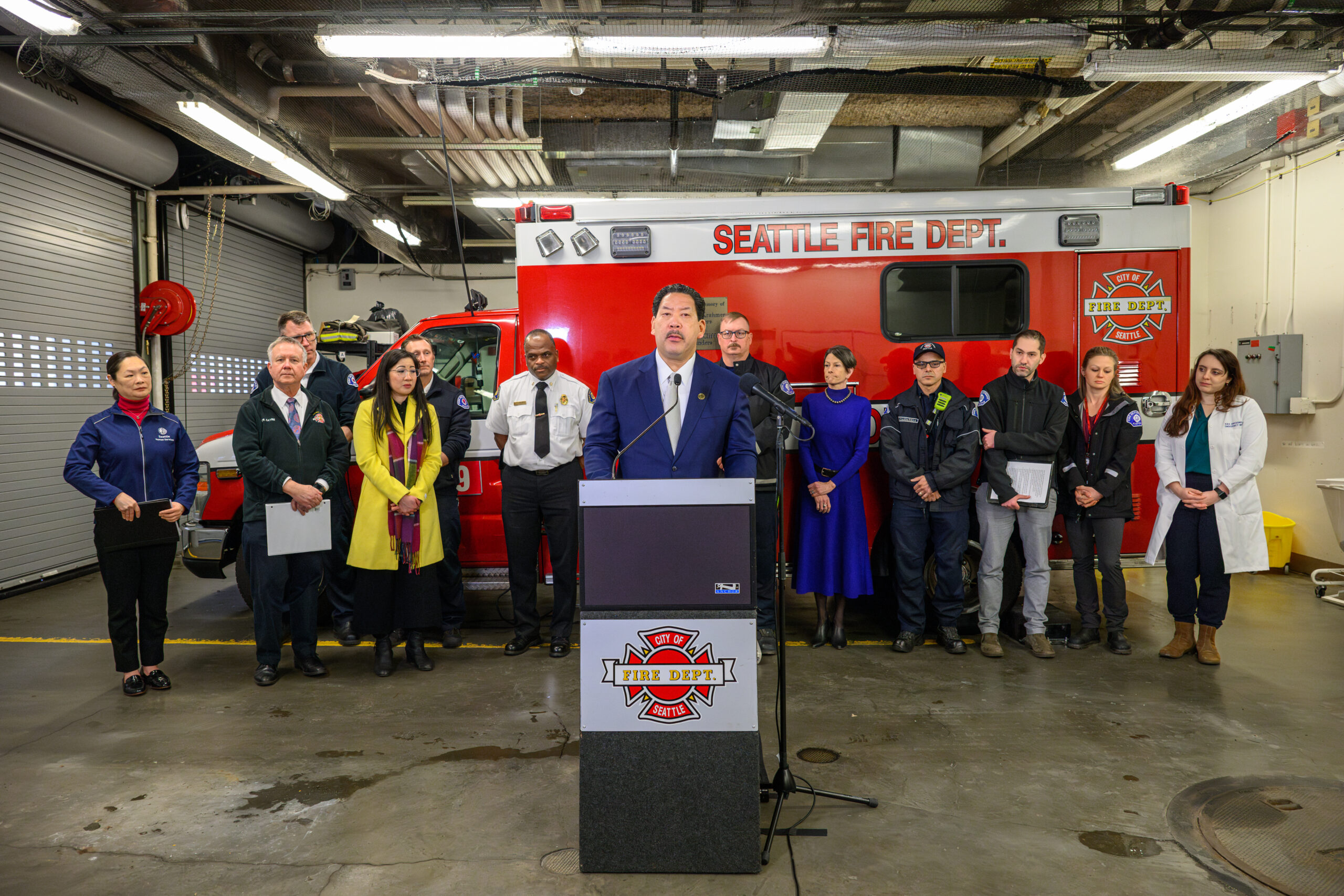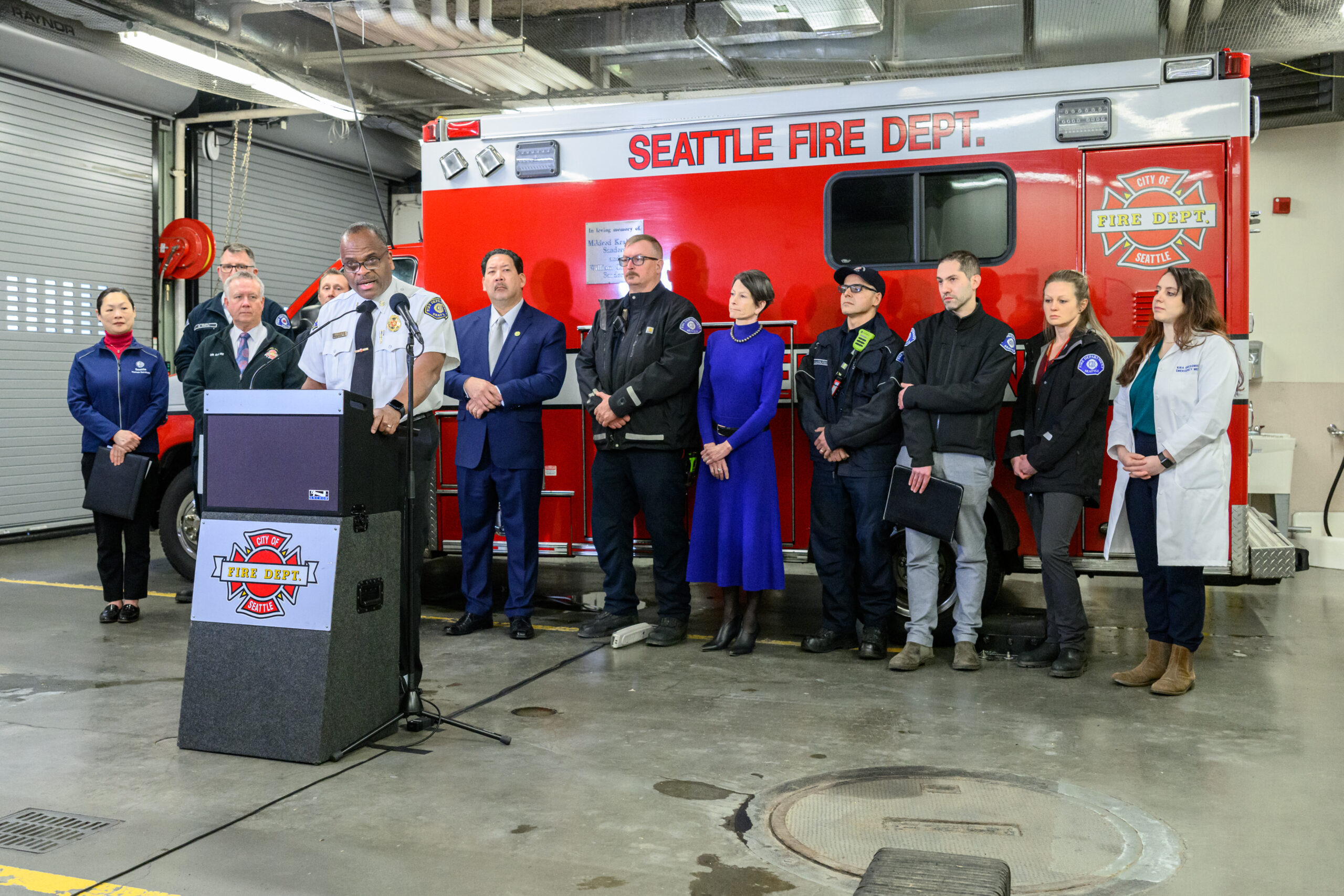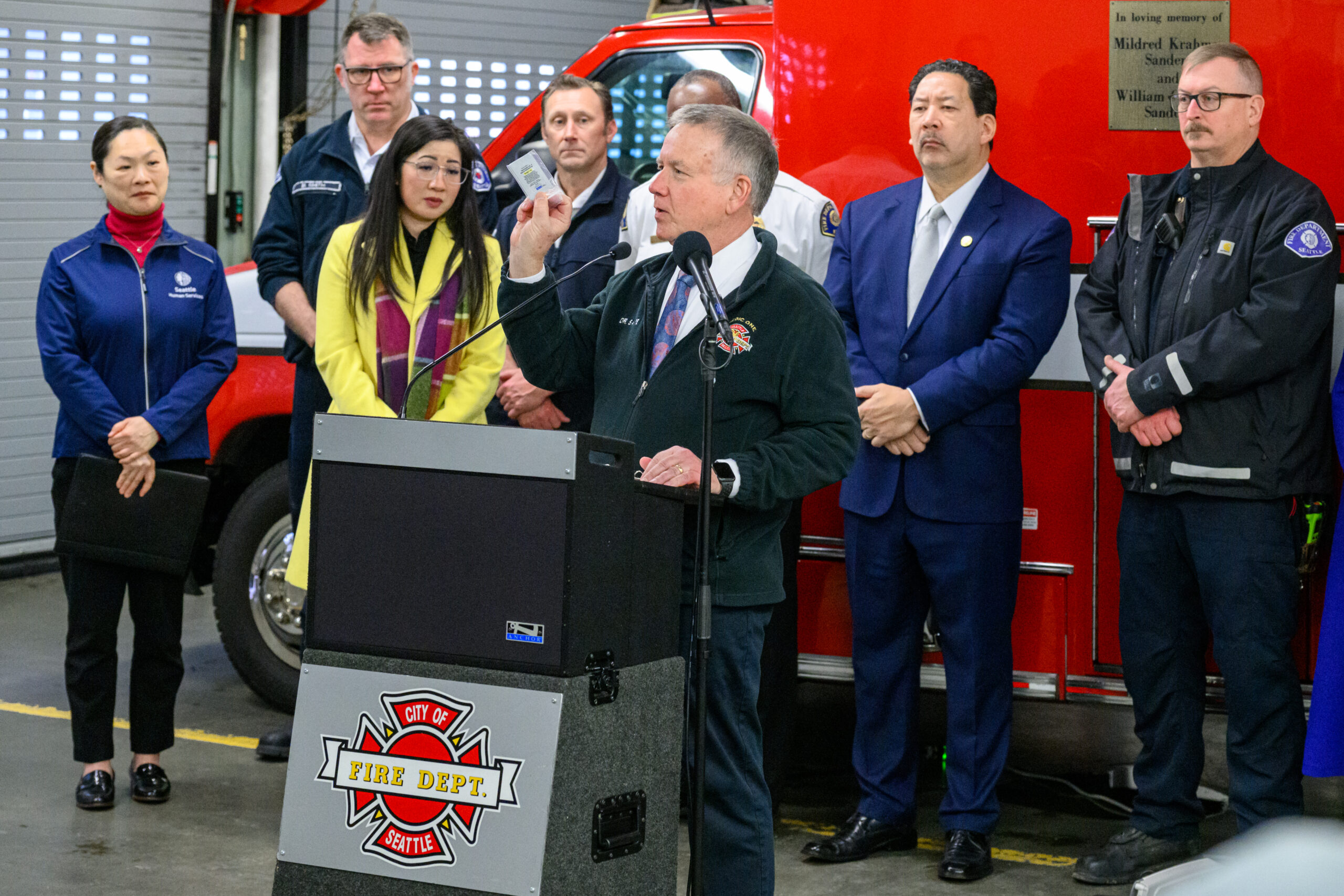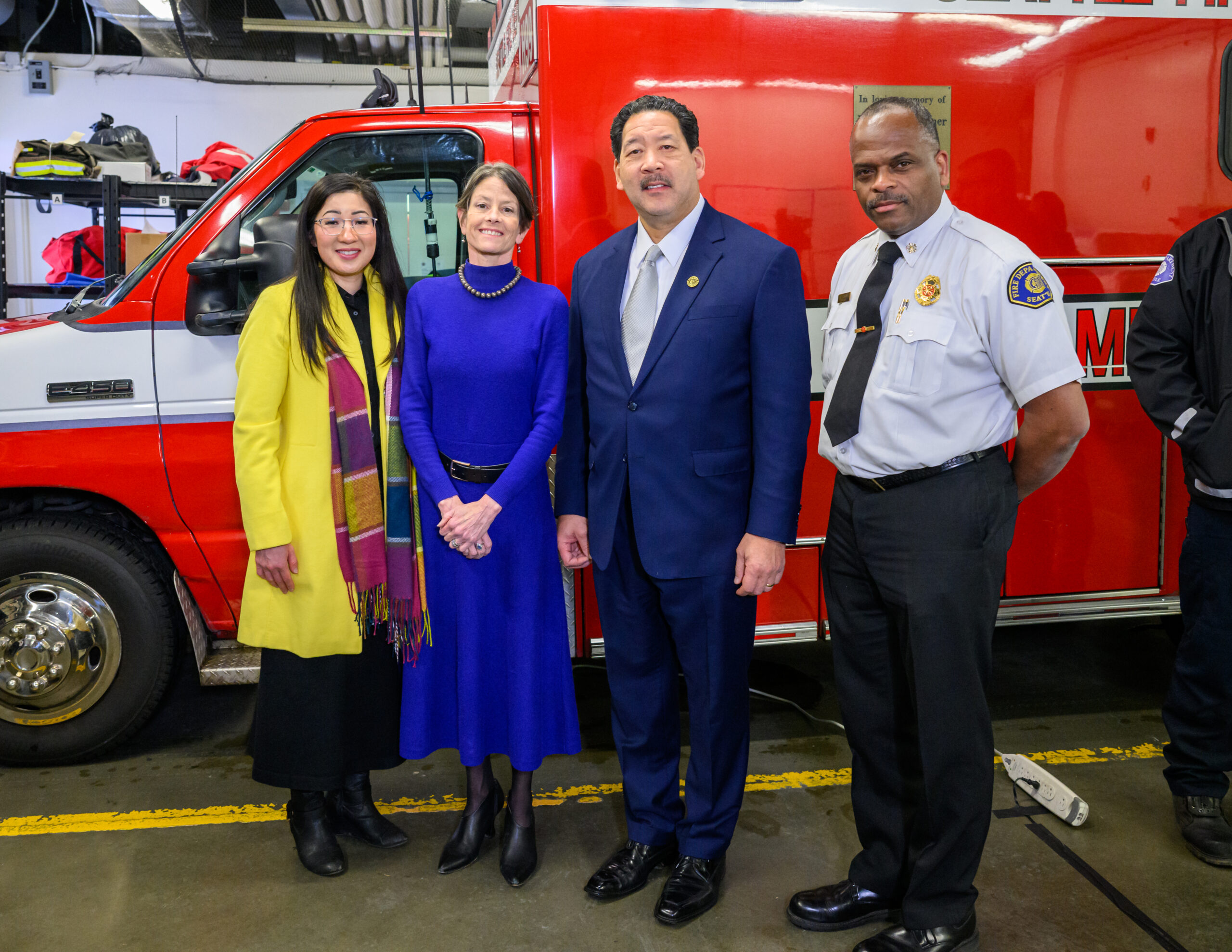
SEATTLE – Mayor Bruce Harrell joined Seattle Fire Department (SFD) Chief Harold Scoggins, SFD Medical Director Dr. Michael Sayre and other leaders today to announce the launch of a new pilot program in Seattle that allows SFD’s paramedics to administer a new medicine in the field. The medication, with a generic name of buprenorphine, is given to patients who are being treated for an opiate overdose or to those actively experiencing withdrawal symptoms. This medication temporarily stabilizes patients and provides short-term relief from withdrawal symptoms to allow the teams to better engage in conversations around treatment, recovery, and social services.
“The fentanyl and synthetic opioid crisis that is killing people on our streets and in our neighborhoods demands that we use all tools at our disposal to save lives and be innovative in how we connect people to treatment services,” said Mayor Bruce Harrell. “This new pilot program will allow our Seattle Fire Department paramedics to administer this highly effective and evidence-backed medication that quickly stabilizes people suffering from opioid use disorder, creating a window where services are more likely to be accepted and reducing the strain on our city’s emergency rooms. Combined with our other health-focused efforts like the Health 99 overdose response team and upcoming post-overdose recovery center, we are creating a cohesive and supportive ecosystem of services to break the cycle of repeated overdoses and help get more people on a path to recovery and wellness.”
Currently, the SFD responds to more than 100 patients each week experiencing an overdose. Further, in 2023, Public Health – Seattle and King County reported that 735 people died of drug overdoses in Seattle.
Regular use of buprenorphine has been shown to cut mortality from opioid addiction in half. This medication helps patients recover from the withdrawal effects after an overdose is reversed with naloxone. A single dose of buprenorphine provides 24 to 48 hours of protection from opioid overdose. Relief of withdrawal symptoms provides an opportunity for engaging patients in conversation about treatment, recovery, and social service connections.
“Seattle firefighter/EMTs and paramedics are on the frontlines of the fentanyl and synthetic opioid epidemic and respond on a daily basis to patients who have overdosed. Equipping our paramedics with the ability to administer buprenorphine further opens the door for conversations with patients around treatment options. Just as our Health 99 post-overdose response unit has had success in helping to combat the epidemic, we expect this program to do the same,” said Fire Chief Harold Scoggins.
SFD’s pilot program began on Feb. 20 following approval by the Washington State Department of Health. Currently, a total of 10 SFD paramedics have received training to administer the medicine in the field, and the department plans to expand. When a patient experiencing withdrawal symptoms is encountered as a result of a 9-1-1 response, if paramedics involved in the pilot are on the response, they will offer the patient an initial dose of buprenorphine. Withdrawal symptoms include agitation, racing heart, runny nose, yawning, nausea, vomiting, diarrhea and other unpleasant symptoms. Since the pilot’s launch, the fire department has administered the medicine eight times.
“Within minutes after an overdose is reversed with naloxone, many patients experience severe and painful withdrawal symptoms. They often leave the scene to find more fentanyl to treat the withdrawal. Giving buprenorphine in that moment changes the whole conversation,” said SFD’s Medical Director Dr. Michael Sayre.
Administering buprenorphine in a pre-hospital setting is just the latest step the City of Seattle is taking to help combat the fentanyl and synthetic opioid epidemic. In July of 2023, the fire department launched a pilot program for a post-overdose response team called Health 99, which is a unit staffed with firefighter/EMTs and a case worker that responds to overdose calls in the City.
Once a patient receives a dose of buprenorphine, Health 99 may respond to the scene to begin a conversation around treatment options. Many times, patients will be transported to an Emergency Department or a center that offers care for post-overdose treatment, like Hobson Place or the King County Pathways Clinic.
“The need for prehospital buprenorphine was one of the top findings of our Health One Post-Overdose Response Team pilot evaluation. Giving this drug in the field dramatically increases the likelihood of our teams being able to engage and successfully follow-up with clients to help connect them with recovery services,” said Mobile Integrated Health program manager Jon Ehrenfeld.
February of 2024 marked 6-months of Health 99 becoming operational. Below are key highlights of the unit’s initial success:
- Responded to 273 incidents, 210 of which were suspected overdoses
- Facilitated 69 warm hand-offs to other providers and treatment centers
- Distributed 110 Narcan kits
- Since the launch of buprenorphine in the field, Health 99 has been involved five of eight times of when the medicine has been administered, resulting in connecting patients with services
The Seattle Fire Department is among the first emergency medical services (EMS) agencies within the State of Washington to administer buprenorphine in the field and is likely within the top 20 in the United States.
Building on Mayor Harrell’s $7 million investment in capital improvements for treatment facilities to address the fentanyl and synthetic opioid crisis, the location and provider of a post-overdose recovery center will be announced next month to help more people access lifesaving treatment services following non-fatal overdoses.



What People Are Saying
Council President Sara Nelson, Seattle City Council
“More people died of drug overdose in Seattle than COVID-19 and the rate of fatal overdoses has only accelerated since the pandemic. We must expand our response to the fentanyl crisis and this commonsense pilot program will give our firefighters another tool to save lives.”
Councilmember Tanya Woo, Seattle City Council
“We’ve seen with our own eyes the suffering caused by opioid abuse and withdrawal. With the urgency and magnitude of this drug crisis, we need to give the firefighters and paramedics all the tools they need to provide life-saving treatment when they arrive first on the scene. Based on my experience with the C/ID Community Watch Program, I feel confident that with the launch of the Mayor’s pilot program, more people will receive better care, and more lives will be saved.”
Councilmember Bob Kettle, Seattle City Council
“Seattle Fire Department paramedics are often the first responders on the scene after someone has overdosed. It’s critical that they have every tool at their disposal to save lives. I am proud to support the critical work they do every day in our community. It’s going to take our entire public safety and public health systems working together with our communities to overcome this unprecedented opioid epidemic. This is an important step in that direction.”
Tanya Kim, Director, Seattle Human Services Department
“We work with Seattle Fire on this pilot, providing an immediate trauma-informed response to people experiencing overdose, to ensure they are safe and at lower risk of future overdose and/or early death. By combining immediate medical treatment with the social service connections that individuals with substance abuse disorder need, we have another tool to effect change and support interventions that can lead to a chance at life.”
Brad Finegood, Strategic Advisor, Public Health – Seattle and King County
“When first responders respond to someone who is having an adverse response to substance use, the ability to refer and rapidly connect people to health resources, overdose prevention tools like naloxone, and buprenorphine, are critical to reducing the risk of overdose and withdrawal symptoms. This evidence-based practice reaches people at a critical time and builds on the many public health efforts to increase access to medications to treat opioid use disorder.”
Lisa Daugaard, Co-Executive Director, Purpose Dignity Action and Dr. Cyn Kotarski, CoLEAD Medical Director, Purpose Dignity Action
“We’re so pleased that Seattle Fire is embracing this pilot to offer immediate access to buprenorphine after overdose reversals. Not only will this reduce the likelihood of additional overdoses in the immediate aftermath — it also offers a more humane, less painful and distressing, experience for the individual, and represents a heightened level of care that we’d all want for ourselves or our loved ones.
Dr. Caleb Banta-Green, Director, Center for Community-Engaged Drug Education, Epidemiology & Research
“Opioid use disorder treatment medications need to be available as easily as possible and in as many places as possible. Paramedics providing treatment medications is a welcome addition to our ever-expanding continuum of care for our neighbors with opioid use disorder.”
Steve Woolworth, Chief Executive Officer, Evergreen Treatment Services
“We fully support this pilot program and view it as an important effort not only to keep more people alive, but also to establish another pathway into evidenced-based care and toward improved well being for folks struggling with opioid use disorder.”
Dr. Callan Fockele, Emergency and Addiction Medicine Physician, Harborview Medical Center
“Buprenorphine is one of the most effective medications I prescribe in the emergency department, reducing mortality of people with opioid use disorder by 50%. Paramedics carrying buprenorphine have the opportunity to provide overdose survivors with effective, compassionate, and life-saving care at the moment of crisis. Expanding this service will be an incredibly important step to address the opioid epidemic in our community.”